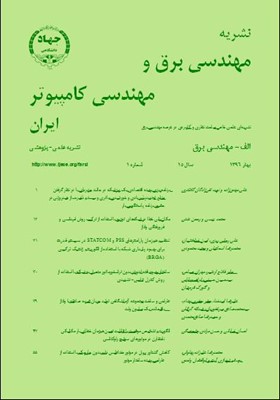مکانیابی خطا در شبکههای توزیع با استفاده از ترکیب روش امپدانسی و فرورفتگی ولتاژ
محورهای موضوعی : مهندسی برق و کامپیوتر
1 - دانشگاه خلیج فارس
2 - دانشگاه خلیج فارس
کلید واژه: بارزدايي ولتاژي باس مؤثر توان راکتيو حساسيت ولتاژ پایداری ولتاژ,
چکیده مقاله :
شبکههای توزیع در تمام سطوح شهرها و روستاها گسترده شدهاند و این شبکهها دارای انشعابها، زیرانشعابها و بارهای زیرخط میباشند. مکانیابی دقیق خطا در سیستمهای توزیع باعث بهبود شاخصهای قابلیت اطمینان و بازده آنها میشود. در این مقاله یک روش ترکیبی جدید برای مکانیابی خطای تکفاز، دوفاز و سهفاز به زمین در شبکههای توزیع پیشنهاد میگردد. همچنین از یک الگوریتم مکانیاب امپدانسی خطا برای پیداکردن محلهای ممکن خطا استفاده میشود. سپس از روش پیشنهادی با استفاده از الگوریتم تطابق فرورفتگی ولتاژ برای تعیین بخش دارای خطا استفاده میشود. در این روش پس از وقوع خطا، محلهای ممکن خطا با استفاده از الگوریتم امپدانسی تعیین میشوند. سپس خطاهای مشابهی به طور جداگانه در محلهای ممکن تعیینشده، شبیهسازی میشوند. در ادامه ولتاژ ابتدای فیدر ذخیره میشود و آن گاه دامنه و فاز اختلاف ولتاژها تعیین و بانک داده آنلاین تولید میگردد. برای تشخیص خطای حقیقی، دادههای این بانک با دامنه و زاویه اختلاف ولتاژهای به دست آمده و ثبتشده (در ابتدای فیدر) مقایسه میشوند. محل واقعی خطا با مقدار تطبیق هر محل خطای ممکن تعیین میشود.
Load taps, laterals, and sub laterals are different branches of power distribution (PD) networks. In PD systems, reliability indices and their efficiency are improved using an accurate method in fault locating. In this paper, a new combined method for locating single, double and three phase faults to ground is proposed in PD networks. In this article, for finding the possible fault locations, an impedance based fault-location algorithm is used. Then, for determining the faulty section, the new method is proposed using voltage sag matching algorithm. In this method, the possible fault locations are determined, after occurrence of single and double phase faults to ground, using an algorithm which is impedance based fault-location algorithm. Separately, the same fault is simulated in possible locations. Then, at the beginning of a feeder, the voltage is saved and the amplitude and angle of the voltage differences are determined and accordingly, an online data bank is generated. Then, the obtained and recorded amplitude and angle of the voltage differences (at the beginning of the feeder) is compared with that data bank, for the actual fault. By the matching value of each possible fault location, the real location of fault is determined. Compared to the other counterparts, the proposed method is more accurate in locating faults and less sensitive to the fault resistance.

